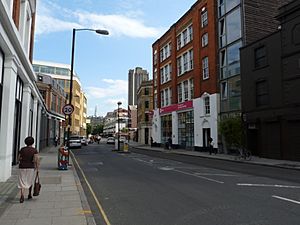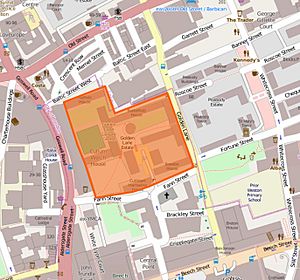Golden Lane, London facts for kids
Golden Lane is a historic street in the City of London, England. It runs from Old Street in the north down to Beech Street in the south. This street has been around since at least 1274. It was once home to the famous Fortune Theatre, built in 1600. Much of Golden Lane was destroyed during World War II bombings but was later rebuilt.
Contents
How Golden Lane Got Its Name
Golden Lane has been known by different names over the centuries, like Goldeslane and Goldyng Lane. Historians believe the street was named after a family who owned land there, possibly linked to someone named Golda in the 1200s.
In 1597, a writer named John Stow described Golden Lane in his book Survey of London. He said that the lane was "filled with many homes of poor people."
The Fortune Theatre (1600s)
One of the most famous places on Golden Lane was the Fortune Theatre. It was built in 1600 for a well-known actor named Edward Alleyn. The theatre was very popular, and Alleyn used the money he earned to start Alleyn's College in Dulwich.
Sadly, the original wooden theatre burned down in 1621. A new stone theatre was built, but it was damaged by soldiers in 1649 and finally taken down in 1661. Later, in the 1660s, a place for young actors called The Nursery was founded nearby. Even the famous diarist Samuel Pepys went to see their shows!
After the theatre was completely demolished in 1661, the land was leased out. A new street was created on the site, which was called Playhouse Yard for many years.
Golden Lane in the 1800s
In 1894, the foundation stone for the former Cripplegate Institute was laid on the west side of Golden Lane. This building served as a library and a theatre. It also taught students drama, opera, and secretarial skills. Today, it is an office building and is considered a historic landmark.
Golden Lane was also one of the first places in London to have gas streetlights. This happened in 1807, making the street much brighter at night!
The Genuine Beer Brewery
A large brewery, first owned by Gideon Combrune, operated on Golden Lane. By 1800, it was producing a lot of ale. In 1804, William Brown and Joseph Parry bought the brewery and renamed it the Genuine Beer Brewery. They wanted to offer lower prices and challenge the big breweries in London.
The brewery grew quickly, becoming one of the largest in London by 1808. They claimed their beer was made only from malt and hops, unlike others that sometimes added different ingredients.
The brewery faced some challenges, including legal cases about how they paid taxes and what ingredients they used. For example, they used a special process involving fish skins to clarify their beer, which was similar to a common ingredient called isinglass. A famous scientist, Humphry Davy, even spoke in court to support the brewery's methods.
However, rising costs and difficulty getting money from investors led to the brewery's decline. By 1827, it was selling much less beer, and the buildings were eventually taken down.
City Bunhill Burial Ground
The land where the Genuine Beer Brewery once stood became the City Bunhill burial ground. This was a cemetery used by non-conformist Protestants from 1833 to 1853. Over 18,000 people were buried there. The burial ground was divided into different sections, with different prices for graves.
Golden Lane Mission
In the mid-1800s, Golden Lane was a very crowded area with many poor people, including street traders. It was described as a "squalid and dirty" place. William James Orsman, who had seen Florence Nightingale's work, founded the Golden Lane Mission. This mission aimed to help the street traders and others living in the area, which was known for its difficult living conditions.
Efforts to Improve the Area
By the mid-1800s, Golden Lane had become a very poor area. Efforts were made to improve it, and an Act of Parliament was even passed in 1877 to help with this. However, the improvement plan faced problems due to disagreements among officials, and the project did not go ahead as planned.
Golden Lane in the 1900s and 2000s
Golden Lane was almost completely destroyed by German bombing during the London Blitz in 1940. After the war, in the 1950s, the area was rebuilt. The Golden Lane Estate, a large complex of council housing (public housing), was built on the land cleared of bomb damage.
Today, Golden Lane is home to various businesses and educational institutions. The offices of the Church Times, a weekly Anglican newspaper, are located there.
The Cordwainers College campus, which is part of the London College of Fashion, is also on Golden Lane.
A modern building called the Golden Lane Campus was completed in 2008. It stands on the site of the old City Bunhill burial ground. This campus includes Prior Weston Primary School, Prior Weston Children's Centre, and the Richard Cloudesley special education needs school.
Images for kids





